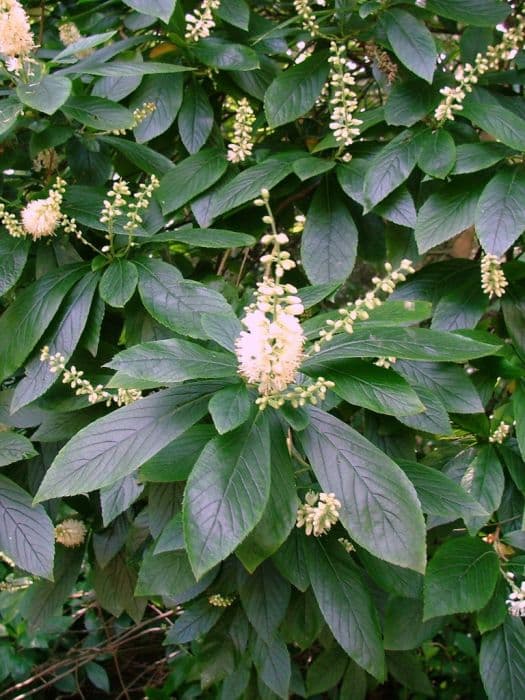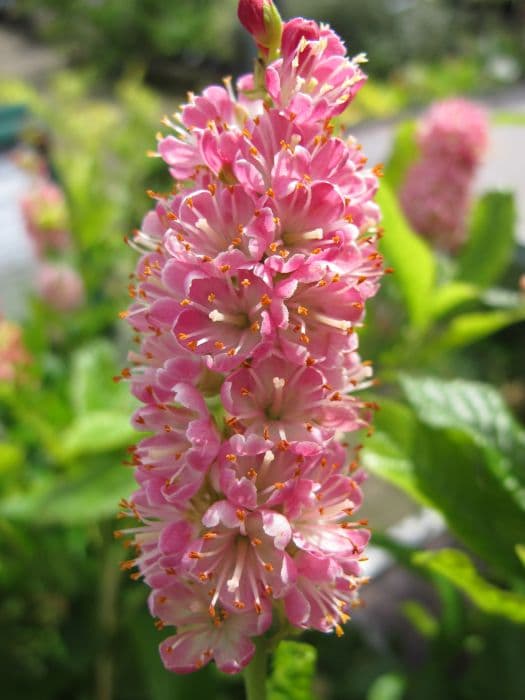Summersweet Clethra alnifolia 'Hummingbird'

ABOUT
The Clethra alnifolia 'Hummingbird', commonly known as the 'Hummingbird' summersweet, is a deciduous shrub known for its attractive and distinctive appearance. Its leaves are a luscious, glossy green, shaped narrow to ovate, with serrated edges that catch the light, giving the plant a vibrant texture. During the summer months, the Hummingbird summersweet becomes a focal point in gardens due to its prolific blooms. The flowers are typically a striking white and present themselves in long, slender racemes, resembling the plumes of an elegant feather. These racemes are tightly packed with small, individual flowers exuding a sweet fragrance which is known to attract an array of pollinators, including the plant’s namesake hummingbirds, as well as butterflies and bees. After blooming, the flowers give way to dark brown seed capsules that can add interest during the fall. In the autumn, the green leaves transform, taking on striking golden-yellow hues before they drop, adding another layer of seasonal interest to the landscape. The bark of the 'Hummingbird' summersweet is a smooth gray, providing a subtle yet pleasing contrast to the lighter tones of its foliage and blooms. This plant boasts a bushy, well-branched habit, often appearing as a rounded mound of foliage and flowers that brings texture and life to any garden setting.
About this plant
 Names
NamesFamily
Clethraceae
Synonyms
Sweet Pepperbush, Summersweet Clethra, Hummingbird Summersweet, White Alder, Coastal Sweet-pepperbush
Common names
Clethra alnifolia 'Hummingbird'.
 Toxicity
ToxicityTo humans
Sweet pepperbush (Clethra alnifolia 'Hummingbird') is not known to be toxic to humans. However, as with many plants, sensitive individuals may have allergic reactions or develop skin irritation upon handling the plant. In general, though, it is not considered poisonous, and no significant symptoms of poisoning are expected upon ingestion. Still, it is not advisable to consume any plant material that is not known to be edible.
To pets
Sweet pepperbush (Clethra alnifolia 'Hummingbird') is not known to be toxic to pets such as cats and dogs. It is generally considered a non-toxic plant for animals. Therefore, if pets ingest parts of this plant, they are unlikely to experience symptoms of poisoning. Nonetheless, it is always prudent to prevent pets from eating plants not intended for consumption to avoid possible gastrointestinal upset or allergic reactions.
 Characteristics
CharacteristicsLife cycle
Perennials
Foliage type
Deciduous
Color of leaves
Green
Flower color
White
Height
3-4 feet (0.91-1.22 meters)
Spread
3-5 feet (0.91-1.52 meters)
Plant type
Shrub
Hardiness zones
4-9
Native area
Eastern North America
Benefits
 General Benefits
General Benefits- Attracts Wildlife: Clethra alnifolia 'Hummingbird' is known for attracting hummingbirds, bees, and butterflies, contributing to pollination and biodiversity in gardens.
- Aromatic Flowers: The plant produces fragrant white flowers, providing a pleasant scent in the garden or landscape during its blooming season.
- Seasonal Interest: With blooms in late summer and yellow to golden-brown fall foliage, it adds visual interest during seasons when many other plants have finished flowering.
- Shade Tolerance: This variety can thrive in partial shade, making it a versatile choice for different garden locations.
- Moisture Tolerance: It is well-suited for wet or moist soils, and can be used in rain gardens or areas with poor drainage.
- Native Plant: As a native species to North America, it supports local ecosystems and is generally adaptive to the regional climate and pests.
- Compact Growth: The 'Hummingbird' cultivar is more compact than the species, making it suitable for smaller gardens.
 Medical Properties
Medical PropertiesThis plant is not used for medical purposes.
 Air-purifying Qualities
Air-purifying QualitiesThis plant is not specifically known for air purifying qualities.
 Other Uses
Other Uses- In natural dye making, extracts from the leaves and bark of Clethra alnifolia can be used to create varying shades of yellow or brown dyes for fabrics.
- As a natural insect repellent, the strong scent of the 'Hummingbird' can dissuade certain insects from lingering in outdoor areas.
- In crafting homemade potpourri, the fragrant flowers can be dried and mixed with other botanicals to create a pleasant room freshener.
- As a companion plant, Clethra alnifolia 'Hummingbird' can be planted near vegetable gardens to attract pollinators, enhancing the yield of pollination-dependent crops.
- In landscape design, the plant is used to create natural privacy screens or hedges due to its dense foliage.
- During winter, the seed pods and bare branches provide textural interest in snow-covered gardens, offering aesthetic value in dormant seasons.
- The wood from mature shrubs can be crafted into small wooden items such as buttons or beads, offering a sustainable source of craft materials.
- Leaves from the 'Hummingbird' plant can be used in natural crafts, like leaf printing or botanical paper making, for adding organic designs to art projects.
- In amateur perfumery, the scent of the flowers might be captured in homemade fragrances or scented oils.
- As part of sensory gardens, Clethra alnifolia 'Hummingbird' is valued for its texture, fragrance, and the gentle sound of rustling leaves, enhancing the sensory experience.
Interesting Facts
 Feng Shui
Feng ShuiThe Summersweet is not used in Feng Shui practice.
 Zodiac Sign Compitability
Zodiac Sign CompitabilityThe Summersweet is not used in astrology practice.
 Plant Symbolism
Plant Symbolism- Attraction: The 'Hummingbird' variety of Clethra alnifolia is named after the bird because it attracts hummingbirds with its flowers, thus symbolizing attraction and allure.
- Sweetness: Known commonly as Summersweet, this plant is associated with sweetness, not only because of its fragrant flowers but also due to its nectar that attract bees and butterflies, reflecting sweetness in life and character.
- Nature's Music: The buzzing of the bees and hummingbirds that the Summersweet attracts creates a symphony of natural sounds, symbolizing joy and the music of life.
- Adaptability: Since Summersweet is adaptable to different soil conditions and can thrive in various environments, it stands as a symbol for adaptability and resilience in life.
 Water
WaterSweet pepperbush 'Hummingbird' requires consistent moisture, so water the plant deeply to saturate the root zone, which generally requires about 1 to 1.5 gallons of water per week, depending on climate and soil conditions. During the growing season, in the absence of rainfall, water the plant once or twice a week, ensuring the soil remains moist but is not waterlogged. Avoid overhead watering to reduce the risk of leaf diseases; instead, water at the base of the plant. During the winter months, reduce watering frequency as the plant's water requirements decrease. Always check the top few inches of soil for dryness before watering to avoid overwatering.
 Light
LightSweet pepperbush 'Hummingbird' thrives in full sun to partial shade conditions. Best growth and flowering are achieved when the plant is placed in a location with morning sun and afternoon shade, especially in the hotter regions to prevent leaf scorch. Nevertheless, the plant is versatile and can tolerate a variety of light conditions but may have fewer flowers in deeper shade.
 Temperature
TemperatureSweet pepperbush 'Hummingbird' is hardy and can survive in a range of temperatures, withstanding minimum winter temperatures down to -20°F. The ideal temperature range for optimal growth lies between 60°F and 75°F. Summer temperatures above 85°F may require additional watering to keep the plant healthy and stress-free.
 Pruning
PruningSweet pepperbush 'Hummingbird' should be pruned to maintain shape and encourage bushier growth with more flowers. Prune in late winter or early spring before new growth starts by removing any dead or damaged branches and cutting back to a healthy set of buds. Pruning can be done annually, but since the plant blooms on new wood, be careful not to remove the current year's growth that will produce flowers.
 Cleaning
CleaningAs needed
 Soil
SoilSummersweet 'Hummingbird' thrives in a well-draining soil mix rich in organic matter, with pH levels between 5.0 and 6.5. A blend of loamy soil, peat moss, and perlite will provide the necessary conditions for healthy growth.
 Repotting
RepottingSummersweet 'Hummingbird' should be repotted every 2-3 years or when it outgrows its current container, to ensure continued health and space for root growth.
 Humidity & Misting
Humidity & MistingSummersweet 'Hummingbird' prefers moderate to high humidity levels but is adaptable to lower humidity environments typical of temperate regions.
 Suitable locations
Suitable locationsIndoor
Place in bright, indirect light with high humidity for best growth.
Outdoor
Plant in partial shade, mulch well, and ensure soil stays moist.
Hardiness zone
4-9 USDA
 Life cycle
Life cycleSummersweet 'Hummingbird', scientifically known as Clethra alnifolia 'Hummingbird', begins its life cycle as a dormant seed which requires stratification to break dormancy. Upon germination in warm, moist soil conditions, the seedling emerges and develops into a young plant with characteristic glossy green leaves. As it matures, the plant grows into an upright, densely-branched shrub, typically reaching around 3 to 4 feet in height. During summer, it produces fragrant white flowers that attract pollinators, leading to seed formation after fertilization. These seeds are then dispersed, often by wildlife or environmental factors such as wind, completing the reproductive cycle. In the fall, the plant exhibits another significant stage as its leaves turn yellow to golden brown before it enters a period of dormancy during the cold winter months.
 Propogation
PropogationPropogation time
Late winter
Clethra alnifolia 'Hummingbird', commonly known as Summersweet or Sweet Pepperbush, is commonly propagated by softwood cuttings taken in late spring to early summer. To propagate by cuttings, select healthy, non-flowering shoots of the current year's growth. Snip off a 4 to 6 inch (roughly 10 to 15 centimeters) section of stem, just below a node, where the concentration of rooting hormones is highest. Remove the leaves from the lower half of the cutting and dip the cut end in a rooting hormone powder or gel to encourage root development. Plant the treated cutting in a pot filled with a mix of peat and perlite to ensure good drainage and moisture retention. Keep the soil consistently moist and cover the pot with a plastic bag or place it in a propagator to maintain high humidity around the cutting. Roots typically form in a few weeks, after which the new Summersweet plants can be transferred to individual pots to grow on before planting out.

